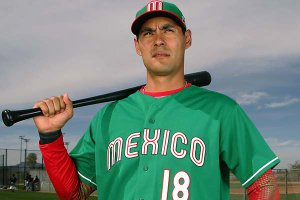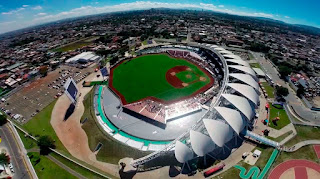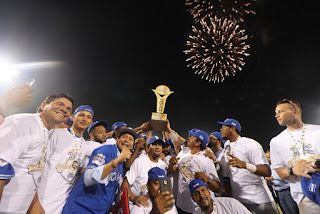 |
| Mexico's new Baseball Hall of Fame in Monterrey |
The previous Hall of Fame, located on the Cuauhtemoc Moctezuma brewery grounds in Monterrey, was shuttered by the host company in 2012 after nearly four decades at that location, leading to all items in the building spending the past seven years boxed up in a storage unit while a new venue was sought. At that time, according to Puro Beisbol editor Fernando Ballesteros, Sinaloa governor Mario Lopez Valdez, proposed that a new Salon be built in Culiacan but that building never came to fruition.
In the end, it was Harp who came to the rescue by funding the new state-of-the-art facility, which occupies over 185,000 square feet and took two-and-a-half years to build. Besides five display rooms honoring the country's past greats of the game, the new Hall also features three floors including a library, 180-seat theater, batting cages with pitching machines, a mini-stadium suitable for wiffleball and space for weddings and baptisms (with a restaurant to open soon) and includes 280 parking spaces, many of them underground. It is regarded as the most modern building of its kind in Latin America.
 |
| AMLO (left) and Alfredo Harp Helu |
One of those current members, Enrique Kerlegand (a writer who arguably took on the title "Dean of Mexican Baseball Cronistas" following last year's passing of Tommy Morales), had to wait for over an hour on the outside sidewalk because he was not listed as one of the registered guests. In addition, none of the enthroned attendees was mentioned during the ceremony although many traveled a long distance to be there for the opening. Four new members will become the first inductees since 2011 later this year: former players Fernando Valenzuela, Ricardo Saenz and Daniel Fernandez as well as longtime administrator Chito Rodriguez. Given the more recent history between Harp's Diablos Rojos and Valenzuela's Quintana Roo Tigres, an introduction of "El Toro" might have led to an uncomfortable moment for all involved.
Still, the glitches were relatively minor compared to the overall effort, which was indeed a celebration of baseball in Mexico. While Baseball Mexico has not always been easy on his Mexico City team, there is no problem acknowledging the contributions that Alfredo Harp Helu has made to the sport in his country, from operating an academy in Oaxaca and paying for a new shrine to the King of Sports to the gleaming new 13,000-seat ballpark in Mexico City that'll open in early April and host the LMB All-Star Game in July. While Lopez Obrador may be taking on the title of Mexico's Biggest Baseball Fan, Harp has to be considered its greatest modern benefactor and he deserves credit for that.
AMLO ORDERS FORMATION OF TEN BASEBALL ACADEMIES
 |
| Edgar Gonzalez to oversee 10 Mexican academies |
Gonzalez, who managed Mexico in the 2016 World Baseball Classic, is now a coordinator for the President's Office for the Promotion and Development of Baseball. Along with father David and brother Adrian, he has operated baseball academies in Southern California and Tijuana for the past decade. There are several existing academies in Mexico, the most prominent being one operated by the Mexican League near Monterrey, but the ten proposed by AMLO would mark the first government-subsidized effort in that facet of player development. The proposed locations are San Quintin, Baja California Norte; Guasave and Etchojoa, Sinaloa; Delicias, Chihuahua; Hidalgo, Tamaulipas; Minatitlan, Veracruz; Iztapalala in Mexico City; Palenque, Chiapas; Cardenas, Tabasco and Ticul, Yucatan.
The academies would be geared toward players signing contracts with Major League Baseball organizations along with pro circuits in Mexico. During an interview with Pereyra, Gonzalez said "If each of the ten academies produces six players per year, in six years a number up to 60 to 80 is conservative." When asked how realistic the numbers are, he replied, "Yes, we can generate them. Last year we sold six players to MLB teams from the Academia de Nosotros (in Tijuana)."
The effort will face an uphill battle. Since Melo Almada debuted with the Boston Red Sox in 1933, 133 Mexican-born players have spent time in MLB, the most recent being San Diego shortstop Luis Urias, who debuted with the Padres last August. However, the number of Mexicans in MLB has dropped from 23 in 2003 to 13 last year. Both Gonzalez and Lopez Obrador believe there is enough talent in Mexico to send to MLB at the same rate as the Dominican Republic and Venezuela, where Pereyra says a combined 1,500 private academies have sold 2,400 players.
As a nod to the fact that only two percent of signed prospects reach the majors and even fewer remain in the bigs long enough to consolidate a career at that level, Gonzalez says the academies will also place an emphasis on academics so young players who don't turn pro may earn scholarships in Mexican and U.S. universities instead. He adds that unlike past scenarios in which MLB teams have had to pay Mexican League teams holding the rights to young players 35 percent of their signing bonus, the academies would allow parents to negotiate directly with big league organizations, although there would be an academy representative on hand to oversee talks. "If you leave the father alone," Gonzalez notes, "a team will talk to a player worth 200 thousand dollars but offer five thousand, since he doesn't know what he is going to take. If you have a representative, you can help him get what his son is worth." The ex-Padres second sacker says the academy would take a commission of 5 to 10 percent to help offset the cost of training a young player.
Gonzalez added that while he will report directly to the president, he'll primarily coordinate his efforts with National Commission of Physical Culture and Sports Ana Gabriela Guevara. In addition, he will not have an office because Lopez Obrador wants him to spend money on ballplayers, not bureaucracy.
VINNY CASTILLA NAMED MANAGER IN HERMOSILLO
With the Mexican Pacific League's offseason less than a month underway, a pair of former homegrown sluggers are returning the the LMP in new non-playing roles.
 |
| New Hermosillo manager Vinny Castilla |
The 51-year-old Castilla was born and raised in Oaxaca before signing with the Mexican League's Saltillo Saraperos as a shortstop in 1987. After limited duties his first two seasons (including a short stint with Monclova), Castilla broke out in 1989 by batting .307 for the Saraperos, including 10 homers and 58 RBIs in 128 games. That was enough to attract the attention of the Atlanta Braves, who bought his contract from Saltillo after the season. He then spent three more years in the Braves system, including brief appearances with the big team in 1991 and 1992. It wasn't until after Castilla had been picked by Colorado in the expansion draft that the right-handed batter's career really took an upturn.
After spending the 1993 as the Rockies' starting shortstop (batting .255 with seven homers) and splitting 1994 between Denver and AAA Colorado Springs as a utilityman, Castilla was installed as the regular third baseman by manager Don Baylor and responded with a five-year stretch during which he hit 191 homers, drove in 562 runs, topped the .300 mark four times and made two All-Star Game appearances while winning three Silver Slugger awards as the National League's top-hitting third baseman. Following the 1999 season he was traded to the Tampa Bay Devil Rays and never really regained his form except for a one-year return to Coors Field in 2004 (.271 with 35 homers and an NL-best 131 RBIs). He played his last game in 2007 with the Washington Nationals and remains the all-time leader among Mexican-born MLB players in homers (326), doubles (349), RBIs (1,105), hits (1,881) and runs (902).
Castilla went on to play 67 games with Hermosillo between 2006-07 and 2010-11 (managing the team briefly in 2008-09), batting .276 with 15 homers and 57 RBIs while appearing at the hot corner in every contest before retiring as a player at 42 in 2011. Since then, he's worked in the Rockies front office and as a coach. Castilla has also managed Mexico's national team in the 2007 Pan-American Games (earning a Bronze medal) and in the 2009 World Baseball Classic, reaching the second round of that year's tournament.
 |
| Luis Alfonso Garcia poses in his WBC jersey |
From that point on, he became one of Mexico's most respected batters with both the Monterrey Sultanes of the Mexican League and Hermosillo in the LMP, routinely reaching double-figure totals for homers in both loops. His best year was likely 2010, when Garcia hit .338 with 21 homers and 86 RBIs for Monterrey before going .301/21/60 with Hermosillo in the winter for a total of 42 roundtrippers and 146 ribbies over 159 games. Garcia then spent two summers in Japan for the Rakuten Golden Eagles with middling results, batting .245 with 15 home runs in 165 games for 2012 and 2013 before returning to Mexico for good. The 6'4" right-handed batter retired as a player last fall after batting a combined .280 with seven longballs in 50 games over two short seasons with Oaxaca and Durango. Garcia led the MexPac in homers four times (his 148 career dingers are sixth all-time in the LMP) and played for Mexico in the 2006 and 2013 World Baseball Classics.
Garcia has never worked in a baseball front office and will assume his new position under owner Dio Alberto Murillo, a man whose desire to win is well-known and one who couldn't have enjoyed a winter in Mexicali during which his Aguilas missed the playoffs after posting an LMP-worst 26-40 record.













